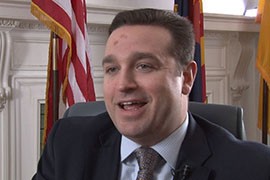Cronkite News has moved to a new home at cronkitenews.azpbs.org. Use this site to search archives from 2011 to May 2015. You can search the new site for current stories.
Advocates welcome FAA’s proposed rules on commercial drones
WASHINGTON – Drone advocates welcomed a Federal Aviation Administration proposal Monday that would allow commercial use of unmanned aerial systems – drones – in U.S. airspace.
The proposed regulations, announced Sunday, are the first step toward opening the sky to small commercial drones that currently have to go through a “cumbersome” process to get permission to operate.
It will be months before the proposed rules can take effect, but one backer called it a “big deal” that could finally open the doors to a multibillion-dollar industry with many different applications.
“You have crop surveying. Potentially you have infrastructure inspection, the motion picture industry,” said Mark A. Aitken II, government relations manager of the Association for Unmanned Vehicle Systems International.
“There’s a lot of low-hanging fruit out there that folks are just clamoring to have the opportunity to use these systems to do things a little bit more efficiently and even more cost effectively,” said Aitken. His association in 2013 estimated that commercial use of drones could have an $82 billion economic impact in the first 10 years after they are integrated into U.S. airspace.
Srikanth Saripalli, an associate professor at Arizona State University’s School of Earth and Space Exploration, also applauded the proposed regulations.
“The FAA’s official policy was that you cannot fly UAS systems for commercial use, period,” said Saripalli, whose research focuses on robotics and unmanned aerial vehicles. “It’s a good step. It’s in the right direction.”
The regulations have been years in the making. They would apply only to commercial drones under 55 pounds, limiting their use to daylight hours within sight of the drone operator, flying below 500 feet and 100 mph, among other restrictions. They would not apply to hobbyists or model aircraft enthusiasts.
The rules would require that operators are certified – but they would not have to have a pilot’s license and their drones would not have to meet FAA airworthiness standards required of traditional aircraft.
President Barack Obama also issued a memorandum Sunday directing federal agencies to set up policies on the types of data that can be collected by government drones and how such information can be used, among other guidelines.
The FAA rules will undergo a 60-day public comment period before any further action can be taken.
“This industry has been flourishing for the last few years and there’s been really a lack of a regulatory framework for people to figure out how they can use these systems commercially,” Aitken said.
“This is the stuff that the FAA has been working on for so many years, just getting this out there and opening it up for comment, it gives us an opportunity, and everyone else out there, to actually comment on the proposals,” he said. “I’m sure the FAA is going to get flooded with hundreds of thousands of comments.”
Brian Hearing agrees that the proposed regulations are long overdue. But Hearing, the cofounder of DroneShield, a company that tries to protect clients from invasion of privacy by drones, thinks the rules are too “conservative.”
“We’re just happy that they issued anything to be honest,” Hearing said. “They had a tough job to do but other countries with equally complex airspace did that job way before us.”
“It’s sad that the U.S. is lagging the rest of the world in the use of drones … a large part of that is because the FAA is dragging their feet,” he said.
Saripalli disagreed, praising the framework.
“The FAA is being careful,” he said. “I wouldn’t say it’s too conservative.”
Aitken concurred.
“I think everyone is just really excited to finally see this and to have a chance to start digesting it and understand what the implications truly are going to be within this industry,” he said.
While the rules still have to be finalized, Aitken is optimistic that the final result will be good for companies looking to use drones in their businesses.
“Hopefully the FAA understands that there’s going to be a period in between actually getting the rules finalized and now,” he said. “If they’re able to continue to work with industry to allow for commercial operations to move forward then that’s a good thing and everyone will continue to win in that.”








